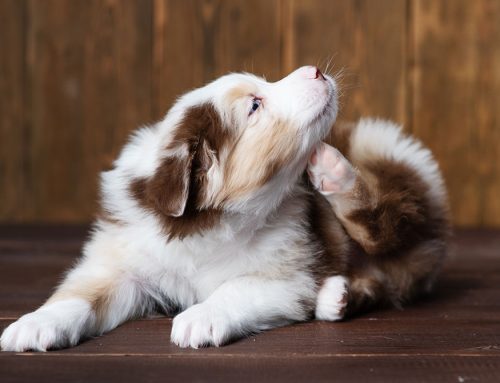Fleas will hop aboard dogs, cats, humans, or any warm-blooded animal in the household. They usually prefer pets to people but when the pets are gone, human ankles are luxurious targets. Children lying on carpets to read or watch television can show characteristic allergic “hives” resulting from the flea bites.
WHAT PROBLEMS DO FLEAS CAUSE?
If you have ever watched a dog attempt to scratch away fleas, you’ll know that control of these insect pests is essential. Aside from the discomfort and itching that flea bites cause, fleas can also cause other health problems. Some pets are allergic to the saliva of the flea and continue to scratch long after the fleas are gone. Damage from scratching continues the irritation and may develop into “hot spots” which are areas of skin infection. Fleas suck blood and anemia can occur in extreme cases. They also transmit bacterial and viral diseases, and pass on a type of tapeworm.
WHERE DO FLEAS COME FROM?
Fleas live almost anywhere. During warm months, they can rapidly multiply in your yard. As your pet walks through the grass, fleas will hop aboard. The outside flea population generally is greatly reduced during our months of cold weather but fleas can easily live year round in your home.
WHAT IS THE LIFE HISTORY OF THE FLEA?
The life of a flea is best described as a cycle which begins with the female laying eggs. These eventually produce more adult fleas that once again lay eggs. Control of fleas is based on this life cycle. Adult fleas jump aboard the pet and take a blood meal. The adult female flea lays hundreds of eggs in her lifetime. Eggs fall to the ground wherever the pet spends his time. They are very resistant to drying, temperature, moisture, and other variables. Flea eggs hatch into the larval stage. The larvae feed on available organic material and go through 3 molts. They prefer dark, quiet areas such as cracks along baseboards and in crevices of furniture. The larval stage can vary from 9 to 200 days. The third stage, larva spins a cocoon and becomes a pupa. Pupae are very resistant to methods of control. The pupa stage lasts 7 days to 1 year. The cocoon finally opens and an adult flea emerges. Hungry, it immediately looks for a meal in a warm-blooded animal.
HOW DO I GET RID OF FLEAS?
Prompt, thorough treatment of fleas on your pet and in your home is the best method of control. Spending the time and money in doing a good job initially will save time, money, and aggravation in the long run. The majority of adult fleas on your pet can be killed quickly with initial treatment, but unless you also treat your environment, the problem will recur as the other flea stages emerge into adulthood. Be sure to follow all instructions carefully. Combining insecticides or misusing these products can cause toxicities.
Please feel free to stop in the hospital for assistance in choosing the best flea products for your situation. It is helpful to know the square footage and layout of your home in deciding the size and number of products to use for the house. Also, be sure to let us know if you have already been treating your pet with any flea products.







Leave A Comment